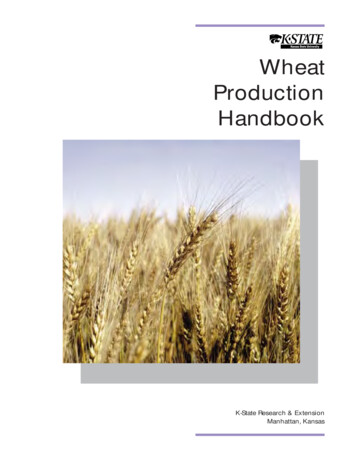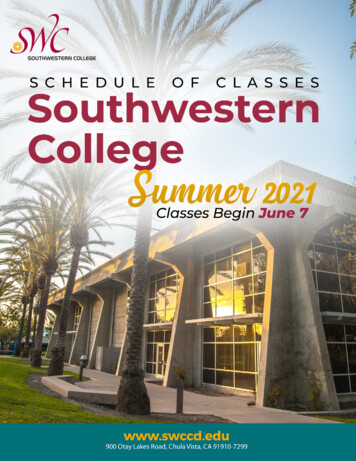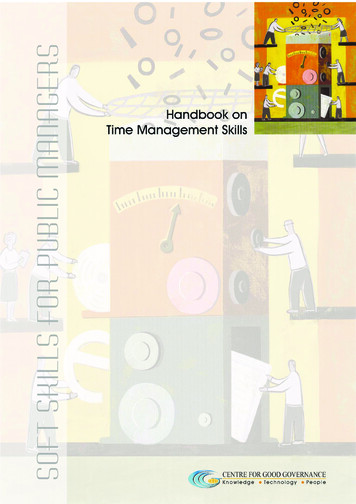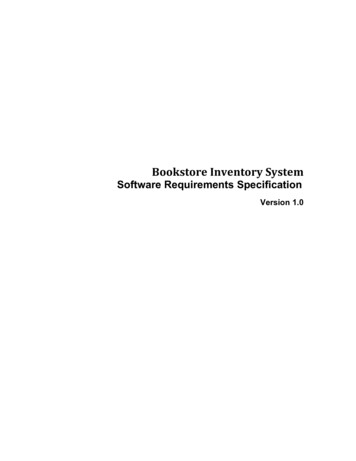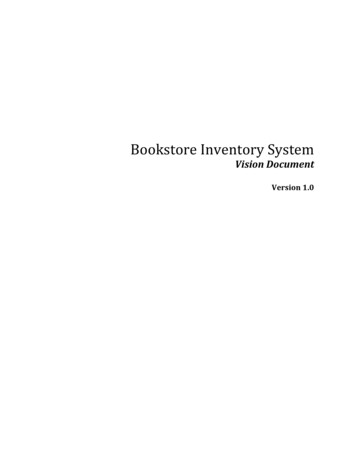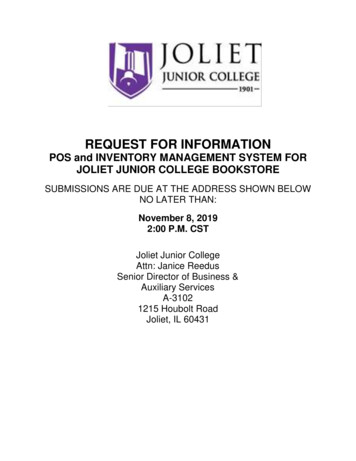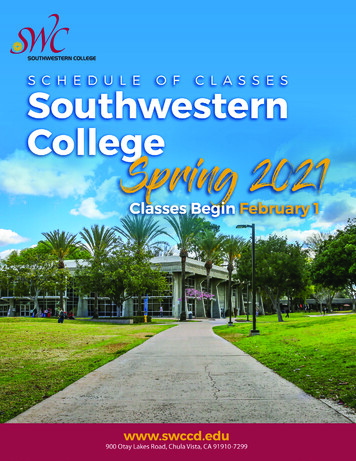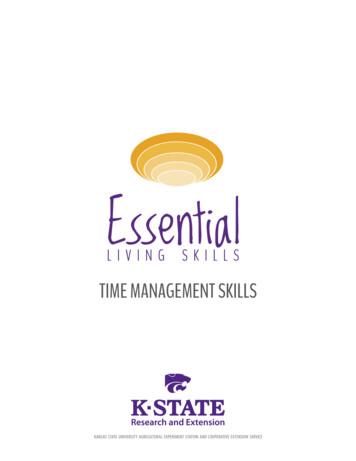
Transcription
TIME MANAGEMENT SKILLSKANSAS STATE UNIVERSITY AGRICULTURAL EXPERIMENT STATION AND COOPERATIVE EXTENSION SERVICE
AcknowledgmentsWe wish to express our appreciation to the original reviewers for the Basic Living Skills — Time Management series:Connie McNair, Shawnee County Extension, Nutrition Assistant; Martha Murphy, Crawford County Extension Agent,EFNEP; Fran Richmond, Osage County Extension Agent, Family and Consumer Sciences; Kendra Stover, Shawnee CountyExtension, Nutrition Assistant; Denise Sullivan, Leavenworth County Extension Agent, Family and Consumer Sciences;Andrea Walker, Ph.D. Candidate, Department of Family Relations and Child Development, Oklahoma State University;Becky Welton, Extension Program Assistant, Haskell UniversityOriginally developed by:Doris “Katey” Walker, Extension Specialist, Family Resource Management and Public PolicyEmily Mark, Extension Specialist, Family and Consumer Sciences, Northeast AreaUpdated by:Elizabeth Kiss, Ph.D., dekiss4@k-state.edu, extension specialist in Family Resource Management, K-State Research andExtension
ContentsESSENTIAL LIVING SKILLS – TIME MANAGEMENT SKILLS4 Evaluation14 Leader’s Guide18 Time: A Special Resource20 Leader Activity: Time Toss21 Activity: My Time Use Bingo22 Time: Where It Goes24 Leader Activity: My Time Picture25 Activity: Your Daily Time Use Chart26 Time: Do First Things First28 Leader Activity: Important - Urgent . . . Your Choice29 Activity: Setting Priorities30 Time: Make Your Own Plan32 Leader Activity: The Time Line33 Activity: Be Your Own Time Keeper34 Time: The Stress Connection36 Leader Activity: Going Around in Circles38 Activity: A Contingency Plan39 Time: Work Smarter, Not Harder43 Leader Activity: The Time Waste Shuffle45 Activity: How to Break Down a Task47 Activity: Prime Time - Energy Time3
EVALUATIONEvaluation instruments are included to measure progress toward the followingoverall objectives:A. Participants will determine which time management skills they want to acquire orimprove.B. Participants will develop and implement a plan to achieve these skills.C. Participants will increase their competencies in time management.Participants may write NA in any blank if it is not applicable to their situation.Participant’s name will not be attached to this piece of paper or to answers.Confidentiality will be respected at all times. The information participants share withus will help us evaluate, develop and deliver Extension Family and Consumer Sciencesprograms more effectively.Participants should return their completed evaluations to their local extension agent orprogram facilitator.4Essential Living Skills: Time Management Skills
TIME MANAGEMENT SKILLS EVALUATIONMeasurable Objective A: Pre-Assessment“Identifying My Need to Know More About Time Management Principles and Skills”Please use a ü or û or fill in the best answer for each line.How important is it for me to know more about.12345NotImportantAt AllNotImportantNot SureImportantVeryImportantHow I manage my use of time?Where I really spend my time?Whether I use my time on what isimportant to me?What to do to reduce my stress in how Iuse time?How to use my time to balance my life?Essential Living Skills: Time Management Skills5
TIME EVALUATION: A SPECIAL RESOURCE— Instrument to be administered before classes —Measurable Objective B: “My Plan for Improving My Skills”1. During the next six months, I would like to improve my skills in how I manage myuse of time:o Yes o No2. My goals for positive change in the area of how I manage my use of time:(please check all that apply)o Think about my time use as way to a happier life.o Learn to plan time use carefully.o Learn what are my time wasters.o Other3. Date I plan to achieve these goals: .4. My plan for achieving these goals includes:o Making a list of how I use my time.o Discussing my time use with others.o Other5. My plan for putting these goals for time management into action includes:o To know that I have time resources.o Review my list of how I use my time.o To avoid spending my time on things that don’t help me reach my goals.o Other6Essential Living Skills: Time Management Skills
TIME EVALUATION: WHERE IT GOES— Instrument to be administered before classes —Measurable Objective B: “My Plan for Improving My Skills”1. During the next six months, I would like to improve my skills in where I really spendmy time:o Yes o No2. My goals for positive change in the area of where I really spend my time: (please checkall that apply)o Learn where I spend my time.o Know that I have choices for my use of time.o To have time to . (Your choice)o Other3. Date I plan to achieve these goals:4. My plan for achieving these goals includes:o Make a log of how I spend my time. 1 day, 2 days, 3 days, one weeko Identify my time challenges.o Adjust my time use to . (Your choice)o Other5. My plan for putting these goals for time management into action includes:o Arrive to appointments/job on time.o Have time for myself to . (Your choice)o Spend time with family and friends.o Have time to do household activities.o Read to my children.o OtherEssential Living Skills: Time Management Skills7
TIME EVALUATION: DO FIRST THINGS FIRST— Instrument to be administered before classes —Measurable Objective B: “My Plan for Improving My Skills”1. During the next six months, I would like to improve my skills in my use of time onwhat is important to me:o Yes o No2. My goals for positive change in the area of my use of time on what is important tome: (please check all that apply)o Decide what is urgent.o Decide what is important.o Learn to set priorities that support my responsibilities.o Work toward doing what really needs to be done.o Other3. Date I plan to achieve these goals:4. My plan for achieving these goals includes:o Make a to-do list.o Select one urgent action.o Select one important task.o Other5. My plan for putting these goals for time management into action includes:o An urgent action I will do today .o An important task I will do today .o Other8Essential Living Skills: Time Management Skills
TIME EVALUATION: MAKE YOUR OWN PLAN— Instrument to be administered before classes —Measurable Objective B: “My Plan for Improving My Skills”1. During the next six months, I would like to improve my skills in how to plan and dowhat is important to me:o Yes o No2. My goals for positive improvement in the area of how to plan and do what isimportant to me: (please check all that apply)o Learn how to make a plan.o Make a plan that fits my needs.o Learn to act on my plan by importance of the items.o Decide what does not have to be done.o Other3. Date I plan to achieve these goals:4. My plan for achieving these goals includes:o Make a plan to accomplish important things.o Make a “to-do” list.o Give priority to important A items; if time allows, do B and C items.o Other5. My plan for putting these goals on how to plan and do what is important to me intoaction includes:o Define a “to-do” list.o Act on importance of items.o OtherEssential Living Skills: Time Management Skills9
TIME EVALUATION: A STRESS CONNECTION— Instrument to be administered before classes —Measurable Objective B: “My Plan for Improving My Skills”1. During the next six months, I would like to improve my skills in what to do to reducemy stress in how I use time:o Yes o No2. My goals for positive change in the area of my use of time on what is important tome: (please check all that apply)o Learn what situations cause stress in relationships.o Learn what to do to reduce stress when rushed.o Learn ways to reduce emergency situations.o Other3. Date I plan to achieve these goals:4. My plan for achieving these goals includes:o Identify what stresses me in relationships.o Identify what stresses me when rushed for periods of time.o Identify what stresses me when emergency situations occur.5. My plan for putting into action these goals for reducing my stress related to time useincludes:o Develop a technique to better manage stress.o Develop a plan for handling emergency situations.o Develop a plan for ways to reduce emergency situations.o Develop a positive attitude.o Use humor.o Other10Essential Living Skills: Time Management Skills
TIME EVALUATION: WORK SMARTER, NOT HARDER— Instrument to be administered before classes —Measurable Objective B: “My Plan for Improving My Skills”1. During the next six months, I would like to improve my skills in how to use time tobalance my life:o Yes o No2. My goals for positive change in the area of how to use time wisely to balance my life:(please check all that apply)o Learn about effective time use.o Learn about how to determine prime time.o Learn to prevent problems.o Learn to balance time use.o Other3. Date I plan to achieve these goals:4. My plan for achieving these goals includes:o Determine prime time for me.o Avoid interruptions.o Take control of how I give time away.o Reduce procrastination.5. My plan for putting into action these goals on how to use time wisely includes:o Use prime time effectively.o Divide big tasks into manageable actions.o Make sure to give myself time.o Develop a positive attitude.Essential Living Skills: Time Management Skills11
TIME MANAGEMENT SKILLS EVALUATIONMeasurable Objective C“Evaluating My Progress Toward Meeting My Goals”Please use a ü or û or fill in the best answer for each line.1I Do NotPlan toChangeProgress I have made toward accomplishing mygoals in these areas 23I Plan toChangeI HaveMadeLimitedChangeHow I manage my use of time?Where I really spend my time?If I use my time on what is important tome?How to plan and do what is important tome?What to do to reduce my stress in how Iuse time?How to use my time to balance my life?12Essential Living Skills: Time Management Skills45I HaveI AmMade ManyMeeting MyPositiveGoalsChanges
TIME MANAGEMENT SKILLS EVALUATIONMeasurable Objective D: Follow-up“An Assessment of How My Time Management Activities Affect My Health andWell-Being”Please use a ü or û or fill in the best answer for each line.How often does the following occur 12345NeverSometimesAbout Halfof the TimeOftenAlwaysI manage my use of time.I know where I really spend my time.I use my time on what is important tome.I plan and do what is important to me.I have reduced my stress in how I usetime.I use my time to balance my life.Essential Living Skills: Time Management Skills13
Comments/NotesLEADER’S GUIDEPROGRAM DESCRIPTIONThis program is designed to assist adults, particularly thosewho are feeling overwhelmed, facing changes, or who lackmanagement experience, to use their time to achieve their goalsin life.Many people feel guilty if they can’t “do it all” and areuncomfortable in protecting their resource of time. They wantto be seen as helpful, caring, and generous and do not alwaysrealize this can lead to tremendous time pressures as they seekto keep everyone else happy. Many individuals find it requiresconsiderable effort and practice to become effective in their useof time to achieve their goals.This lesson series will help individuals set basic priorities basedon the aspects of their life that they have determined as mostmeaningful and most important.The lessons focus on personal, family, and household time use,although the methods suggested may also apply to paid workor volunteer situations. Attitudes toward time differ amongindividuals, families, and cultural backgrounds. This seriesis designed to help people manage situations where carefulattention to “clock time” is important. A key concept is thatpeople can make choices about the way they use their time. Anindividual’s need for balance among time uses is recognized asimportant.OBJECTIVESParticipants will learn: How to manage their use of time; Where they really spend their time; How to use their time on what is important to them; How to plan and get done what is important to them; What to do to reduce their stress in using time; and How to use their time.CONTENTSThe lesson series includes six topics: Time: A Special Resource (How to manage their use of time) Time: Where It Goes (Where they really spend their time)14Essential Living Skills: Time Management Skills
Time: Do First Things First (How to use their time on what isimportant)Comments/Notes Time: Make Your Own Plan (How to plan and get done whatis important) Time: The Stress Connection (What to do to reduce theirstress in using time) Time: Work Smarter, Not Harder (How to use their time toachieve goals)The suggested sequence is for a series of group lessons. The firsttopic might easily be included by the lesson leader as part of anoverall introduction.The sixth topic consists of a variety of management techniquesthat can be used in many different situations.A pre-assessment form to help participants identify their ownneeds and interests should be completed at the first session andreturned to the lesson leader.A general get-acquainted and sharing activity is alsorecommended for the first meeting. Three suggestions arepresented in this leader’s guide.The pre-assessment forms and participant planning forms canbe given at the first meeting to help participants decide whatthey want to know more about. This provides the leader theopportunity to select topics or add emphasis to others.Sharing of ideas among participants is an effective learningexperience. It is important to remember that managing time isan individual choice. What works well for one person may ormay not work well for another. No one should criticize the wayanother person does things.The Evaluating Progress Toward Meeting Learning Goals formcan be given at the beginning of the session, following the lessonseries, and/or at 6 months and 12 months, to assess participants’accomplishments.The lessons can be given on a one-on-one basis. Each fact sheetis a separate topic and can be given to those who prefer to readon their own.Each lesson includes: A fact sheet Learning activities — to do at the group meeting or as atake-home project (assignment) Evaluation formsTwo learning activities are available in support of each fact sheetand are in support of its measurable objectives. One activityinvolves leader preparation and direction for a group activity. Theother activity handout can be used in class or independently, andinvolves the participant in inventories of skills, needs, logs, andEssential Living Skills: Time Management Skills15
written assignments. Please keep the group’s abilities and needsin mind and make adjustments to the activities as necessary.PLANNING THE LESSONThis lesson will provide your group members with an overviewof basic time management principles and ways to apply theprinciples to their own situation.Preparation Review this teaching guide and the fact sheets carefully asyou begin planning your presentation. Make enough copies of the fact sheets for everyone in yourgroup. Make a copy of each evaluation form for each group member. Select one or more learning activities. Gather supplies and make other copies of information ifneeded. Decide what parts of the fact sheet you think are mostrelevant to your group, based on their choices as much aspossible. Remember that sharing experiences is often the mostvaluable learning activity — although you need to watchthe time and keep the discussion moving to avoid too muchrepetition.Try to emphasize exchange . . . giving as well as getting ideas.ExampleExample of a time schedule is: 5 minutes 10 minutesWarm-up activity.Presentation of principles or key conceptsin your own words. 10 minutesGroup members complete one or morelearning activities. 2 minutesDistribute the fact sheet now or at theclose of the lesson. 5 minutesComplete the program evaluation. 5 minutes16Ask each person to share one idea theyhave learned or reviewed.Essential Living Skills: Time Management SkillsComments/Notes
Example of Three General Introductory ActivitiesTime Use Cards ActivityComments/NotesGive each person a 3-by-5 card.Tell them they don’t have to write their name. Ask them to jotdown one of the following:1. Something they would like to have more time for, such assomething they like to do for fun or relaxation.2. One specific challenge they have with time management,such as being late, or not having time to spend with theirchildren, not getting housework done, or not having timeto be physically active. (Ask them to be specific — not justindicate an overall lack of time.)Pictures ActivityCut out and bring some pictures (from magazines or cartoons)that show people doing things that take time (such as a person,family, or other group working, traveling, eating, preparing food,reading, or enjoying being outdoors). You will need a few morepictures than the people in your group. Put the pictures out on atable.Ask each person to select one picture and tell the group why theychose it. Suggest that they think about the picture in terms ofsomething they like to do, would like to have time for, or was aspecial time in their lives.This activity is good for groups of people who don’t know oneanother. Describing a picture is often easier for shy people tobegin talking in front of the group.FOR FURTHER INFORMATIONSeveral other parts of the Essential Living Skills curriculumprovide supplementary information on several topics. Thesections on Controlling Clutter (in Essential Home Maintenance,S134C), Money Management (S134G) and Keeping a Job (in JobReady Skills, S134A) might be particularly helpful.Essential Living Skills: Time Management Skills17
TIME MANAGEMENT SKILLSTIME: A SPECIAL RESOURCETime is a special resource because it takes time to accomplish anything. The way you managetime, like the way you manage your money, energy, and other resources, plays a large part indetermining the goals you can accomplish, and the satisfaction you receive from everything youdo.You really manage yourself with regard to time. There are many ways to make the most of yourtime.TIME IS: Measured — by clock or calendar, by season, by life stages. Limited — we all have 24 hours. Unique — we really manage ourselves in relation to time. Perishable — we cannot save it for future use. Money — it has a dollar value. The key — to finding satisfaction and enjoying life.Time is a special resource for anyone trying to meet family, work, community, and personalneeds. Some say time is the most valuable of all resources because it is limited. Others thinktime is endless . . . thinking they can always do their tasks at another time. Most busy peoplehave to plan carefully to meet all their time demands. Jobs, schools, and other events require youto be on time, even though you would prefer a more relaxed schedule.Time itself is not the real problem: The key is how you use your time. Time cannot really bemanaged; you manage yourself in terms of time use.THINK ABOUT TIMETime is unique. It is the only resource every person has in equal amounts. We all have 24 hoursa day.Time is perishable. You cannot really save time. You can “lose it or use it.” A problem withtime as a resource is that you cannot borrow minutes from one day, and use them the next day.Although time cannot be saved, you can use your time effectively through careful planning andaction.Time is a measure. When time is discussed, many people think first of the clock. Americatends to be a clock-and-calendar centered society. Being on time for work, school, andappointments, and for payments such as rents and bills, is a necessity for almost everyone today.In other cultures, time may be measured by the sun and the seasons.Fact Sheet18KANSAS STATE UNIVERSITY AGRICULTURAL EXPERIMENT STATION AND COOPERATIVE EXTENSION SERVICE
TIME MANAGEMENT SKILLSTime has a dollar value. An old proverb tells us, “Time is money.” It takes time to earn money.It takes time to develop new resources. It takes time to get the most from your shopping dollar.Sometimes you choose whether to “buy time” in the form of convenience foods or householdrepairs.Time has other values. We look for “quality time” to spend with children and other familymembers. We need time for rest, leisure, and personal renewal, as well as for friends, neighbors,and our community.BALANCE YOUR USE OF TIMEPlan to balance your life and share time with family, friends, neighbors, paid work, andvolunteer work with your church, neighborhood, or community.We all invest time, waste time, and use time. Think carefully about your use of time. Make sureyou invest time in the things that are important to you.Fact SheetKANSAS STATE UNIVERSITY AGRICULTURAL EXPERIMENT STATION AND COOPERATIVE EXTENSION SERVICE19
TIME MANAGEMENT SKILLSLEADER ACTIVITY: TIME TOSSSupplies:Six to 10 inexpensive soft objects, may be pre-labeled or shaped to represent the time useactivity stated such as beach ball with a clock face, soft frisbee with food for meal time, soft carfor travel, etc. Each item should be different in size, shape, or color and easy to catch.Instructions:Ask the group to stand in a circle, with the supply of soft objects to toss. Leader will tossthe first object to someone and state a way to use time. Getting ready, family meals, laundry,cooking, shopping, work, travel to/from work, children’s activities, church, reading, TV, talking,walking, etc.The activity using time will move with the object as it goes around the circle. Explain the needto toss to the same person each time. Now continue with the first object and its use of time,then add another object and its use of time. Continue until you have about five or six objectsrepresenting time use being tossed from person to person.Discussion or reflection questions for group: How did you feel as more objects were added? Why is it harder to manage your use of time with many needs? How do you use time? What are some of your time wasters? What methods or tips do you use to be on time for work and events? How do you invest your time?20KANSAS STATE UNIVERSITY AGRICULTURAL EXPERIMENT STATION AND COOPERATIVE EXTENSION SERVICE
TIME MANAGEMENT SKILLSACTIVITY: MY TIME USE BINGOBelow are 24 squares for you to list one or two words that describe the activities you do for 24hours.Examples: Sleep, getting ready, paid work, reading with children, going to the park, groceryshopping, ENoon1pm2pm3pm4pm5pm6pm7pm8pm9pm10pm11pm Color those that involve family as you use your time Yellow. Color those that involve paid work in Green. Color those that involve rest in Blue. Color those that involve others giving away your time in Orange.Ask yourself:Does the way I use my time make me satisfied?KANSAS STATE UNIVERSITY AGRICULTURAL EXPERIMENT STATION AND COOPERATIVE EXTENSION SERVICE21
TIME MANAGEMENT SKILLSTIME: WHERE IT GOESDo you know where your time goes? Keeping track of how you spend your time for a few dayscan help you figure out what you are doing that works for you and what you would like tochange. You may be surprised to learn how much time you spend doing things that really do notmatter to you.It may take some thought to realize that you can take charge of the decisions related to timeuse. Learning how you use your time now is a good first step in deciding if and how you want tomanage time differently to achieve your goals.You have the right and the responsibility to make choices about where your time goes. It issometimes easier to let other people make all the decisions.TIME USE IN 2014, AVERAGE HOURS PER DAY*Household activities: 1.77 in 2014Eating and drinking: 1.17 in 2014Leisure and sports: 5.30 in 2014Sleeping: 8.80 in 2014Caring for and helping household children, parents: 1.38 in 2014Working, employed persons: 5.33 in 2014Working on days worked, employed persons: 7.75 in 2014*Source: http://www.bls.gov/tus/ retrieved October 5, 2015This is not very satisfactory in the long run, because you may not be spending your time onwhat is really important to you.You usually find you have a number of tasks that must be done within a set time or dateschedule, and have no flexibility. You will also find a number of things that must be done, butthe schedule is flexible. There are also things you want to do just for fun and relaxation.TRACKING YOUR TIMEWhere does your time go now? Think about these categories as you determine how you spendyour time: Eating and sleeping Working for pay Commuting to and from your job Recreation, either at home or away from home Family activities22KANSAS STATE UNIVERSITY AGRICULTURAL EXPERIMENT STATION AND COOPERATIVE EXTENSION SERVICEFact Sheet
TIME MANAGEMENT SKILLS Home and personal care and maintenance Religious activities Community activities Other activities not listed aboveThink about volunteer work, education or training, and other activities that you do. Thecategories are listed to help you in thinking and planning; not to suggest how you should beusing your time.Home, personal, and family activities may include such things as menu planning; foodpreparation and clean-up; household cleaning and maintenance; family care (including physicalcare such as bathing, dressing, and feeding children; as well as maintaining relationships withall family members, such as reading to children or helping them with projects or homework;trips to the doctor or dentist); money management, including paying bills, record keeping, andshopping. Some family and personal activities may fit under recreation.You will see that caring for your family, managing your household, working or going to school,eating, sleeping, and personal care take many hours every day. You must identify your challengesand plan carefully to do those tasks that need to be done, and have some time left for the thingsyou would like to do.IDENTIFY YOUR TIME CHALLENGESTracking your time will help you see where you can do things differently. The limitation of time. Many problems with time occur when you do not accept thelimitations of time. You have to set priorities because you can’t do everything all at once. Balance your time. Sometimes you need to balance your use of time. It is important to maketime for yourself as well as others. Minimizing household work time. Getting the essential household chores done is sometimesthe main challenge. Failing to set priorities. Priority setting is necessary to achieve your goals. Ask yourself, “Isthis the best use of my time?” to decide what is most important.Remember that time management is not a device to make you work harder and longer. It is atool to help you “work smarter,” to accomplish your work more easily and rapidly, and includetime for all the other things you want to do.Fact SheetKANSAS STATE UNIVERSITY AGRICULTURAL EXPERIMENT STATION AND COOPERATIVE EXTENSION SERVICE23
TIME MANAGEMENT SKILLSLEADER ACTIVITY: MY TIME PICTURESupplies:Inexpensive plain white paper plates or 10-inch circles, one per person. Colored markers,crayons, or colored pencils in at least 12 colors.Instructions:Fold the plate/circle in half, fold again, then in half again. You should have eight sections —each of these sections represent 3 hours of your time. They can be divided into smaller amountsto represent the smallest amount of time you use. Prepare and show an example of your timepicture. Identify your time use for the following activities:Where do you spend large amounts of time — at least four or more hours at one time? Referto the fact sheet for categories. Using a different color for each large use of time on an activity,color in total time spent. Do not divide an hour into more than two sections (or thirty minuteseach). Complete your circle, being sure to use a different color for each activity.Some questions for discussion: When you view your time picture, do you feel you get the full use out of your 24 hours? Does your time picture show what you value in the way you use your time? Is there something you have wanted to do but do not find the time for?24KANSAS STATE UNIVERSITY AGRICULTURAL EXPERIMENT STATION AND COOPERATIVE EXTENSION SERVICE
TIME MANAGEMENT SKILLSACTIVITY: YOUR DAILY TIME USE CHARTBelow list the activities you did during the past 24 hours. You may want to keep a chart eachday for a week to get an accurate idea of your daily time use.6AM6PM77889910101111NOONMIDNIGHT1PM1AM22334455 What do you see as your time use challenges? Do they involve people other than you? How might you plan for adjustments in how you use your time?KANSAS STATE UNIVERSITY AGRICULTURAL EXPERIMENT STATION AND COOPERATIVE EXTENSION SERVICE25
TIME MANAGEMENT SKILLSTIME: DO FIRST THINGS FIRSTFinding the time to do the things you need and want to do is often a big challenge. Effectivetime management means deciding what you want out of life and moving toward your goals.Long-term goals are based on the people, activities, and things that give meaning to our lives.Short-term goals help us measure our progress toward long-term goals. Priorities providea ranking of the activities that help us achieve our goals. You may think of goals in severaldifferent categories, such as: goals dealing with physical, mental, emotional, and spiritual health;financial; job; education; family relationships; and social goals.EXAMPLES OF GOAL SETTINGMental — develop an optimistic attitudePhysical — eat balanced meals each daySpiritual — grow in courage, kindness, and unselfishnessFamily — make home life happy and enjoyableJob — improve skills and accuracyFinancial — start a savings accountSocial — get involved in community service activitiesConsider the goals of your family when you set individual goals. To be most successful, familiesneed to agree on the goals to be achieved.WHAT IS IMPORTANT TO YOU?People have many different goals. Goals are the specific things you want to do within a certainperiod of time. They should be challenging, but realistic. You may also need to think about thegoals of family members and others so you can fit them all
A. Participants will determine which time management skills they want to acquire or improve. B. Participants will develop and implement a plan to achieve these skills. C. Participants will increase their competencies in time management. Participants may write NA
